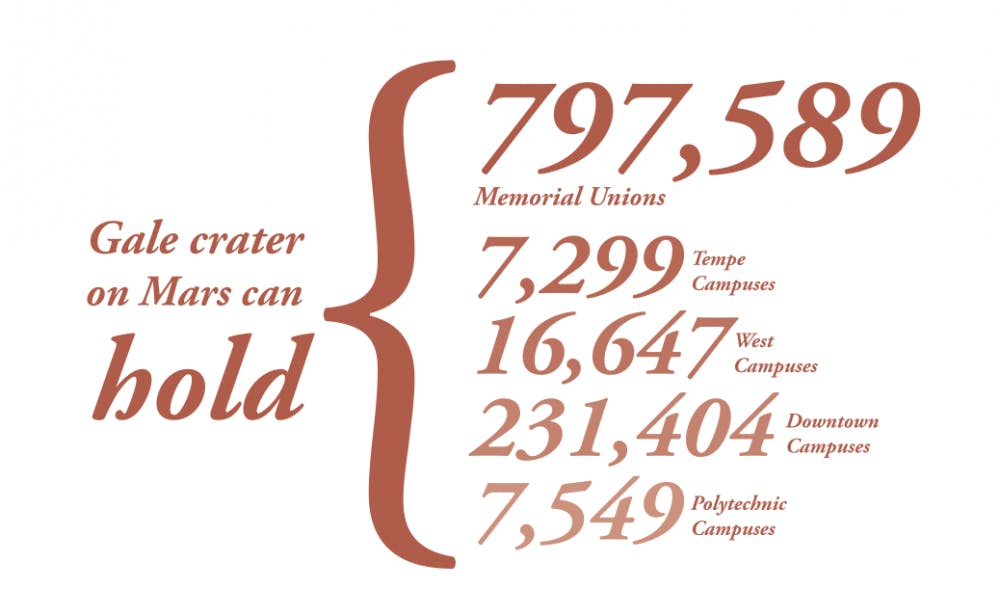A few minutes before 2 p.m., students open the door and one-by-one file into room 240 of the Interdisciplinary Science and Technology IV building.
Typical to any first day of class, the students find their seats and chat with their neighbors. Lori Prause, the teaching assistant, fiddles with a projector, and finally, the shadowed image of a man flashes on the screen.
Dr. Jack Farmer’s voice reverberates off the walls of the room as he instructs the class from the Jet Propulsion Laboratory (JPL) base, the headquarters of the Mars Science Laboratory mission.
This new ASU class will allow students to observe the progress of NASA’s Mars Science Laboratory (MSL) mission. The class, Advanced Field Geology, offers an exclusive look into the MSL mission.
Both instructors, Farmer and Dr. Alberto Behar, work for NASA on the MSL mission’s Mars Exploration Rovers (MER) team, making this class a rare opportunity for ASU students. Farmer says, “As far as I know, this is the only class like this being taught, where MER team members are leading.”
Jim Crowell, a recent graduate and co-founder of the ASU chapter of Students for the Exploration and Development of Space, says he is ecstatic for what the new class could mean for ASU students. “I’m extremely excited. It is a very exclusive opportunity the students have,” Crowell says. “ASU students are getting a backstage pass with the mission because both professors are so hands-on.”
Not only is the subject of the class unique, but the structure of the class uses an innovative dimension. Over the course of the semester, Farmer and Behar will instruct via telecom from JPL in Pasadena, Calif.
The class will start out covering the details of how NASA prepared Curiosity, the Mars rover, for its mission and technological features. Students enrolled in the course will also receive updates of MSL’s progress and hear about the different aspects of the mission from the MSL engineering team. Farmer says the class will be centered on roundtable discussion and be driven by students so they can gain their own insight into the MSL mission.
When relaying the syllabus details, Farmer highlights the potential guest speakers scheduled to present to the class. Farmer encourages his students to research the questions they want ask the high-merited guest lecturers. “The people who will be talking to you are the global experts,” Farmer says. “They are the best in their field.”
Jaret Matthews, the head mechanical/systems engineer for the Lunar Low Temperature Wheels and Prototype Mars Drilling System, and Matthew Heverly, the mobility systems engineer for Curiosity are on the list of scheduled speakers. Ralph E. Milliken, one of the foremost experts on Gale Crater geology, will also make an appearance during a lecture.
Liza Dyer, a senior in the School of Earth and Space Exploration, says she is interested in the engineering aspects of the class: “To get a look at the new technology is really beneficial for me. Engineering stuff is all new to me.”
On Oct. 20, the class is scheduled to visit JPL for a four day trip to get an inside look into the work going on between the scientists and engineers involved with MSL. Farmer says he wants to give the students a look at the project from different angles.
“My plan here is to bring you in contact with members of the JPL on both the engineering and science side. This is something I want to give you because it’s not something you can read about — how the engineering and science teams get together. I want you to walk away with an understanding of how the mission works,” Farmer says to the class.
 This replica of the Mars rover Curiosity sits in the Interdisciplinary Science and Technology Building IV.
This replica of the Mars rover Curiosity sits in the Interdisciplinary Science and Technology Building IV.Photo by Josh Loeser
The Curiosity rover of the MSL mission launched to Mars on Nov. 26, 2011 and landed last month on August 6. The length of the mission will be one Mars year or approximately 23 Earth months. Curiosity will study the geology of Mars to learn whether the planet ever had favorable conditions for life. Farmer sums up the goal of the mission for the students: “This mission is designed to ask the question: did Mars ever sustain life?”
Mike Pagano, a graduate student in the School of Earth and Space Exploration, says he has long been interested in space. “This is one of the most interesting missions in a long time," Pagano says. "Ever since the first mission, I felt attached.”
After the class, Patrick Young, a student in the class and assistant professor of the School of Earth and Space Exploration, says he looks forward to the beginning of the class. “I love this stuff,” Young says. “This is an opportunity I didn’t want to miss.”
When Farmer finishes describing the future of the course, a brief silence encompasses the classroom. Farmer dismisses the students, but his image still illuminates the screen. After a small pause and an encouraging look from Prause, the students get up and walk out the door.
As of Labor Day weekend, a replica of the real rover on the red planet created by Jim Arbaugh is in the Interdisciplinary Science and Technology Building IV. This copy of Curiosity will greet the students of GLG 598 as they enter the building. As the students learn more about Curiosity’s technology and mission, they will pass the Curiosity replica that serves as a connection to the scientists and engineers of MSL.
Reach the writer at kmyklese@asu.edu or via Twitter @mykatiejo





